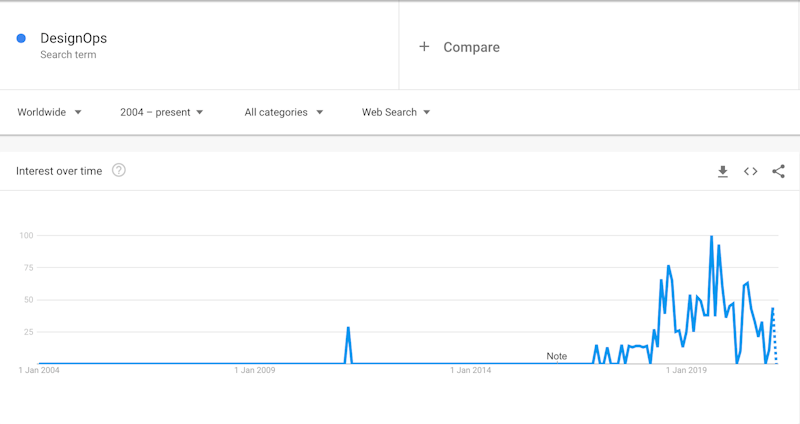In the world of tech, trends are everything. Not too long ago, we had a blockchain everything. Blockchain payment systems, blockchain ride-sharing, blockchain you-name-it. Quite recently we noticed a similar though not as ubiquitous increase in interest with DesignOps. The Google Trends data seems to back our observation up.

Being the design enthusiasts we are, we couldn’t help but ponder whether the new-found interest in DesignOps is justifiable in its utility. Let’s try and work this out.
What’s DesignOps anyway?
DesignOps is a relatively new field of expertise that finds itself at the intersection of Human Resources, Project Management, UX&UI Design, and Design Quality Assurance. According to Fabricio Teixeira's article, the term has been around for about three years as of the article's publishing date. That would make it about 5 years old as of the beginning of 2021. DesignOps as a discipline involves orchestrating people and design processes to maximize the efficiency and value of the design output.
Take a look at the Venn diagram below. We feel like it summarizes the essence of DesignOps best.

What’s the objective of DesignOps?
– Efficiency, better quality a shared team understanding. In the same way, you need a specially trained manager for construction building or software development, design teams have their unique workflows and processes that sometimes need unique management solutions. That’s the main reason DesignOps emerged as its own thing.
Although DesignOps principles are applicable to any (even solo) design teams, the bigger the team gets, the more sense it makes to invest time and resources into orchestrating processes.
The Structure of Design Ops
Out of the disciplines we’ve mentioned above (HR, QA, etc), DesignOps concerns itself with three key challenges that designers face, especially in larger teams. Namely, how they work together, how they get the work done, and how they create impact.
Take a look at the diagram below. It summarizes design ops and its subcomponents.

Let’s go through all of these challenges in more detail.
By the way, Nielsen Norman group organizes the sub-components of DesignOps in a similar way. Feel free to check their awesome article as well.
How we work together
This facet of DesignOps is all about establishing the team dynamics and getting the team on the same page on the roles within the group. There are three important challenges to take into account here:
Defining team roles & responsibilities, and organization;
Collaboration framework;
Growing together.
Let's go through each of these challenges in more detail.
Defining team roles & responsibilities, and organization
Primarily, this subcategory entails making sure you have the people with all of the skills needed for the project. By the way, defining team responsibilities is not something you want to be sorted by itself. That’s because that way you might have multiple people working on the same thing, while some of the tasks will be forgotten about. Also, make sure everyone knows what their responsibilities are in both the short- and long-term.
Collaboration framework
This step involves making sure that the team communicates regularly and has everything it needs to do so. To ensure successful collaboration, one needs to take care of:
Establishing regular meetings & rituals;
Nurturing communication and team spirit;
Making sure designers have all they need to work.
Growing together;
This DesignOps subcategory focuses on growing both extensively and intensively. Therefore, one should have well-established career growth pathways, good onboarding, and a well-defined hiring process that makes use of efficient tools like applicant tracking systems or video interviewing platforms.
How we get work done
Standardizing deliverables;
Whether you’re a solo designer or a large team, you have deliverables and processes that are recurring. These could be simple matters like follow-up emails, or more formidable tasks like design systems. Either way, since these things are recurring templates and standards will lead you a long way in maximizing your efficiency. One of the other benefits is that the results of your team’s work will be consistent regardless of which designer performed the task in question.
Ensuring consistency;
This challenge is similar to the previous one, but it also includes things like communication channels, software, and, of course, design artifacts.
Prioritizing the tasks.
Not every task deserves a lot of attention, effort, and resources. Ideally, you should discuss the task priorities as a team depending on how easy they are to complete, and how important they are.
How we create impact
Aside from the business side of being aware of your progress, there’s also a psychological component to tracking your progress. Creating visible impact is one of the key drivers of human motivation. Here are a few subcategories you should take care of:
Tracking progress. Time tracking software is a good way to track whether your team is improving. Needless to say, this subcategory is vital for a successful design or any other team for that matter.
Educating and learning to become better designers. One of the important aspects of creating impact is making sure to enable the team to do so. In turn, enabling not also involves creating a respective environment, but also fostering education among the team members.
Recognizing achievements. These could be both financial and non-financial incentives to make sure each team member knows that their efforts are recognized and appreciated.
When should you start thinking about DesignOps seriously?
Remember the challenges that good DesignOps solve? As soon as you start noticeably struggling with these challenges, it’s a good time to start thinking about design ops seriously. Usually, you’d only put effort into operations, when there’s a need to maximize efficiency across a large team. DesignOps is not an exception. The larger the team gets, the more rules and structure you need to make sense of the chaos that any collaborative effort would otherwise be.
So is all the fuss worth it?
In our humble opinion, – yes, especially if you’re in a large team. In any case, it’s not like before the invention of “design ops” design teams, small or large, never took the time to organize and structure their work. We think that the true value of coinage of “design ops” is to structure and organize the best practices to help you run your design teams efficiently.





